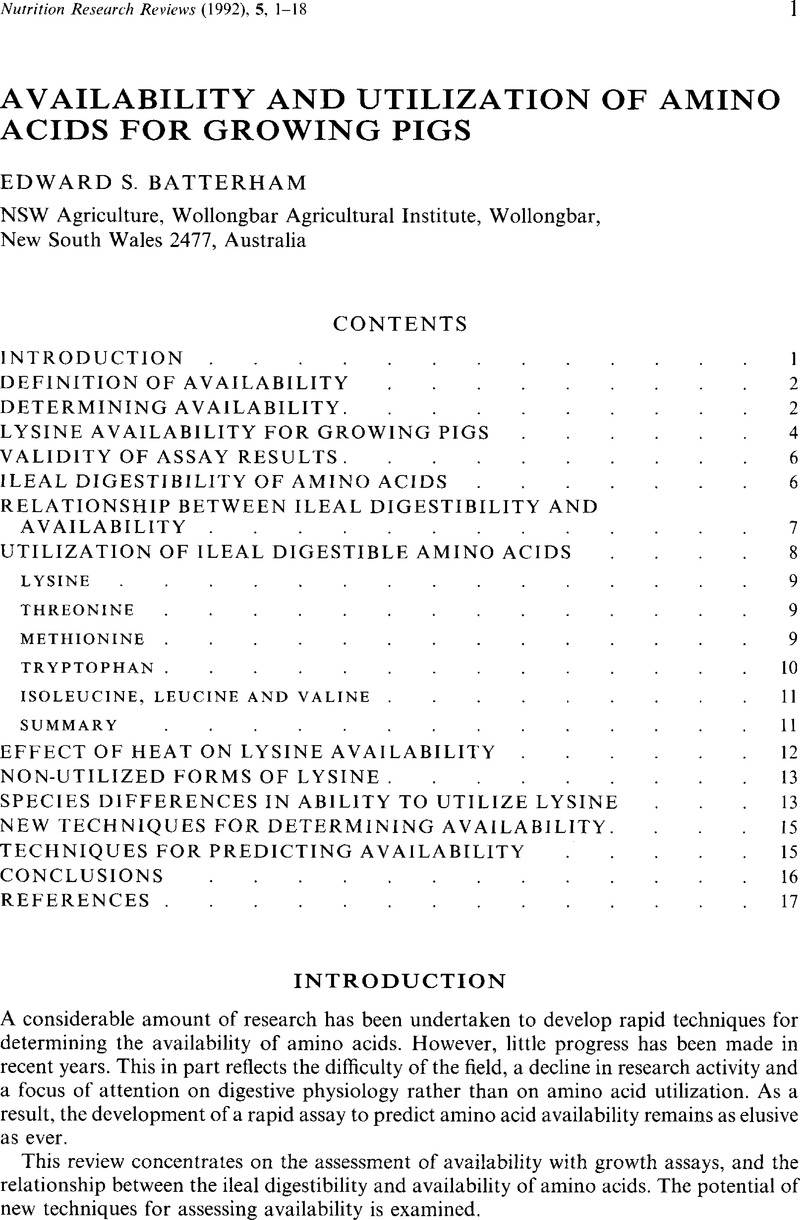Crossref Citations
This article has been cited by the following publications. This list is generated based on data provided by Crossref.
Partanen, Kirsi
1994.
The Effect of Ash Content on the Nutritive Value of Meat and Bone Meal for Growing Pigs.
Acta Agriculturae Scandinavica, Section A - Animal Science,
Vol. 44,
Issue. 3,
p.
152.
Van Barneveld, R. J.
Batterham, E. S.
and
Norton, B. W.
1994.
The effect of heat on amino acids for growing pigs.
British Journal of Nutrition,
Vol. 72,
Issue. 2,
p.
257.
Williams, P.E.V.
1995.
Digestible amino acids for non-ruminant animals: theory and recent challenges.
Animal Feed Science and Technology,
Vol. 53,
Issue. 2,
p.
173.
Annison, G.
Moughan, P. J.
and
Thomas, D. V.
1995.
Nutritive activity of soluble rice bran arabinoxylans in broiler diets.
British Poultry Science,
Vol. 36,
Issue. 3,
p.
479.
Marty, B.J.
and
Chavez, E.R.
1995.
Ileal digestibilities and urinary losses of amino acids in pigs fed heat processed soybean products.
Livestock Production Science,
Vol. 43,
Issue. 1,
p.
37.
Yu, Feng
Moughan, P. J.
and
Barry, T. N.
1996.
The effect of cottonseed condensed tannins on the ileal digestibility of amino acids in casein and cottonseed kernel.
British Journal of Nutrition,
Vol. 75,
Issue. 5,
p.
683.
FERNANDEZ, S.R.
and
PARSONS, C.M.
1996.
Bioavailability of the Digestible Lysine and Valine in Cottonseed and Soybean Meals for Chicks.
Poultry Science,
Vol. 75,
Issue. 2,
p.
216.
Fleming, Ann E.
Van Barneveld, Robert J.
and
Hone, Patrick W.
1996.
The development of artificial diets for abalone: A review and future directions.
Aquaculture,
Vol. 140,
Issue. 1-2,
p.
5.
Yu, Feng
Moughant, P. J.
Barry, T. N.
and
McNabb, W. C.
1996.
The effect of condensed tannins from heated and unheated cottonseed on the ileal digestibility of amino acids for the growing rat and pig.
British Journal of Nutrition,
Vol. 76,
Issue. 3,
p.
359.
Parsons, Carl M.
1996.
Digestible amino acids for poultry and swine.
Animal Feed Science and Technology,
Vol. 59,
Issue. 1-3,
p.
147.
Moughan, Paul J.
and
Rutherfurd, Shane M.
1996.
A New Method for Determining Digestible Reactive Lysine in Foods.
Journal of Agricultural and Food Chemistry,
Vol. 44,
Issue. 8,
p.
2202.
Moughan, Paul J.
Gall, Mark P. J.
and
Rutherfurd, Shane M.
1996.
Absorption of Lysine and Deoxyketosyllysine in an Early-Maillard Browned Casein by the Growing Pig.
Journal of Agricultural and Food Chemistry,
Vol. 44,
Issue. 6,
p.
1520.
FERNANDEZ, S.R.
and
PARSONS, C.M.
1996.
Bioavailability of Digestible Lysine in Heat-Damaged Soybean Meal for Chick Growth.
Poultry Science,
Vol. 75,
Issue. 2,
p.
224.
Grala, W.
Verstegen, M.W.A.
van Leeuwen, P.
Huisman, J.
Jansman, A.J.M.
and
Tamminga, S.
1997.
Nitrogen balance of pigs as affected by feedstuffs causing different endogenous nitrogen flow at the terminal ileum.
Livestock Production Science,
Vol. 48,
Issue. 2,
p.
143.
Prawirodigdo, S.
Batterham, E.S.
Andersen, L.M.
Dunshea, F.R.
and
Farrell, D.J.
1997.
Nitrogen retention in pigs given diets containing cottonseed meal or soybean meal.
Animal Feed Science and Technology,
Vol. 67,
Issue. 2-3,
p.
205.
van Barneveld, Robert J
Szarvas, Stephen R
and
Barr, Andrew R
1998.
The apparent ileal digestibility of amino acids and the digestible energy content of naked oats (
Avena sativa
cv Bandicoot) fed to growing pigs
.
Journal of the Science of Food and Agriculture,
Vol. 76,
Issue. 2,
p.
277.
Wang, X
and
Parsons, CM
1998.
Dietary formulation with meat and bone meal on a total versus a digestible or bioavailable amino acid basis.
Poultry Science,
Vol. 77,
Issue. 7,
p.
1010.
Grala, W
Verstegen, M.W.A
Jansman, A.J.M
Huisman, J
van Leeuwen, P
and
Tamminga, S
1999.
Effects of ileal endogenous nitrogen losses and dietary amino acid supplementation on nitrogen retention in growing pigs.
Animal Feed Science and Technology,
Vol. 80,
Issue. 3-4,
p.
207.
M'ncene, W.B
Tuitoek, J.K
and
Muiruri, H.K
1999.
Nitrogen utilization and performance of pigs given diets containing a dried or undried fermented blood/molasses mixture.
Animal Feed Science and Technology,
Vol. 78,
Issue. 3-4,
p.
239.
van Barneveld, Robert J.
1999.
Understanding the nutritional chemistry of lupin (Lupinus spp.) seed to improve livestock production efficiency.
Nutrition Research Reviews,
Vol. 12,
Issue. 2,
p.
203.





